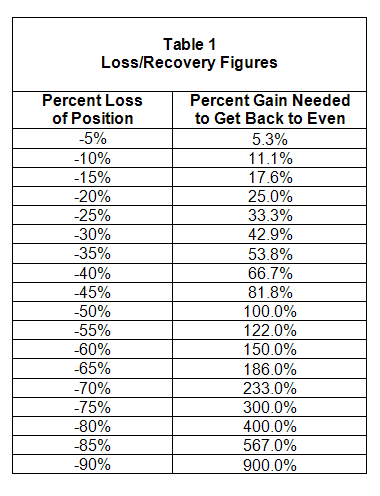When to Sell a Stock
That's Going Down
SPONSOR:
The trend is your friend! Click here to see the Top 50 Trending Stocks.

When to Sell a Stock Quickly & Easily When You're Losing Money
Every trader is going see some stocks decline from the purchase price. The trick is not to lose your shirt, but contain the loss to just a small amount. A trader can easily sustain several small losses, but not ones that lose 35-50% of a position or more. Take a look at Table 1 below to see why big losses just don’t work.

Now that you’ve seen the hard evidence of why you must control losses and know when to sell a stock, the rest of this webpage is comprised of two parts:
- Creating a plan for controlling losses.
- What to do if you have a large loss in your portfolio.
As mentioned in
Learn How to Sell Stock When Emotions Are Kicking In,
if you think of it this way, you might willingly lose $100 on one stock for a gain of $500 on another. That’s the sort of attitude you have to have to not stress yourself out about a loss. If you let a stock position sink, for weeks or months - even years can go by waiting for it to come back. That’s time wasted that could have been in a position that was earning you money.
 Stock traders may often feel that as soon as they sell the stock that the price might jump back up. Nobody wants to lose out on a gain if a stock price reverses after a position is sold, but you’ll feel 10,000 times better by getting rid of the financial and emotional drain if the stock continues downward. That peace of mind and sense of empowerment is worth the selling cost. As an investor, you're in this for the long haul and being in complete control will give you the confidence and capital to go the distance.
Stock traders may often feel that as soon as they sell the stock that the price might jump back up. Nobody wants to lose out on a gain if a stock price reverses after a position is sold, but you’ll feel 10,000 times better by getting rid of the financial and emotional drain if the stock continues downward. That peace of mind and sense of empowerment is worth the selling cost. As an investor, you're in this for the long haul and being in complete control will give you the confidence and capital to go the distance.
Use Price as a Reason to Sell, Not Outside Influences
Contrary to much advice about when to sell a stock, the number one reason for selling a stock is price. If you let price be the ultimate determining factor for selling stock, you remove the problem of indecision around selling. Let me say this again – as a trader who wants to make money, price should always be the controlling factor for selling.
Even if a company’s fundamentals change or markets falter, let a stock’s price and your stop loss be your guide for when to sell a stock – all other reasons you hear for selling stock are simply warning signals alerting you to reevaluate your stop loss on the stock price.
Because the stock price is either in trouble or it’s not. It’s sort of a Taoist approach for when to sell a stock. You remove ego from the action and let the stock price range until it sells. In stock market investing, your ultimate goal is to harness a price movement for a profit.
With the reason to sell based on price performance, the next step is to generate a plan for when to sell a stock.
First, Have a Plan For Controlling Losses
Before ever opening a stock position there are two ways to sidestep losing too much capital. This can be done using position sizing and placing a stop loss on every new stock you buy or sell. So before you even enter a trade this puts two capital protection devices in place.
Position sizing
is how much of your total capital you’ll put into any one position and this can easily reduce the risk of loss.
A stop loss
is a predetermined price point at which you will sell your stock position. This is where you draw a line in the sand, and if the price moves beyond that line the position is closed out. A stop loss is placed immediately after a stock purchase. This prevents a small loss from creeping into a damaging one. The great thing is that it becomes an automatic system and the stop loss will do the hardest part of trading for you. The deciding. And of course, it also limits how much you will lose.
Position sizes and stop losses are planned actions and part of your
stock trading plan
plan before you ever even take a position. Additionally, your trading plan is at the heart of everything you do in stock market investing.
ACTION STEP: Add to your stock trading plan your actions for position sizing and stop losses so you'll know when to sell a stock that's losing you money.
What to Do If You Have a Position at a Loss
Taking a look at Table 1 again you can see how losses can compound if you don't know when to sell a stock.

It’s not always a pretty picture which is why having a good trading plan to start is essential. However, if you’re new to trading stocks and have losses in your portfolio you need to know what to do about them.
If you have a loss between 5% and 15% it’s a good time to put a stop loss on the position.
Stocks with Dividends
Even if you’re getting a dividend from a stock position, too much loss of capital is unacceptable. If you’ve owned a stock for one year that’s gone down 30% and you receive a 3% dividend – that’s a -27% return. Imagine owning a stock that’s gone up 30% and pays a 3% dividend – in contrast, that return would be +33%.
If the loss is greater than 15% and less than 50% it’s best to analyze the position and if the price is still declining, you should sell it. This way you can reinvest the money in a better stock position – one that’s trending in the right direction to get your money working for you again.
If you have a stock position that has a loss greater than 50%, the amount the stock would have to increase is over 100% or more! The choice is up to you whether to keep it in your portfolio as part reminder and part a dream for recovery. Personally, I have a position in my portfolio from several years ago that has a large loss. I keep it in my portfolio as reminder of what can happen if no stop loss is in place. (Oh sure, there’s the dream too.)
ACTION STEP: Look at all of your stock positions and if you have a loser of between 15-50% look at the stock chart to see what the price is doing. If it’s continuing to go downward – sell it. If you have any losses greater than 50%, decide whether it’s too far gone as a loss or worth selling to reinvest the capital. If you have a loss of more than 75% in a position, it’s just become your long-time reminder of what can happen without stop losses. The key here is to make solid decisions about each losing position and move on.
Conclusion
At this point, you have an idea of when to sell a stock and what to do with your current positions.
Having a plan for stock losses will give you an objective perspective so you can accept the losses and move on. However, there are two things to keep in mind. If most of your stocks are going down, you’ve either got a problem with your strategy, it may be that your stop losses are too close to the purchase price or the
general stock market trend
market has changed direction and is adversely affecting your positions. If positions sell out, it’s ok to be in cash during a down market or you can short sell stocks if you’re comfortable. And even in a down market, some long positions may still hang in there.
When you get accustomed to handling stock losses you’ll accept them more easily and they won’t be a drain on your psyche.
Click here if you're ready to shift the emotions that make it difficult to sell stock when you're in crisis mode.
Go to Stock Trading Systems for the next step in Stock Trading Success.
Go From When to Sell a Stock to Online Stock Trading Warrior Home.
Want to Know If Your Stock's In a Trend?








 Stock traders may often feel that as soon as they sell the stock that the price might jump back up. Nobody wants to lose out on a gain if a stock price reverses after a position is sold, but you’ll feel 10,000 times better by getting rid of the financial and emotional drain if the stock continues downward. That peace of mind and sense of empowerment is worth the selling cost. As an investor, you're in this for the long haul and being in complete control will give you the confidence and capital to go the distance.
Stock traders may often feel that as soon as they sell the stock that the price might jump back up. Nobody wants to lose out on a gain if a stock price reverses after a position is sold, but you’ll feel 10,000 times better by getting rid of the financial and emotional drain if the stock continues downward. That peace of mind and sense of empowerment is worth the selling cost. As an investor, you're in this for the long haul and being in complete control will give you the confidence and capital to go the distance.

